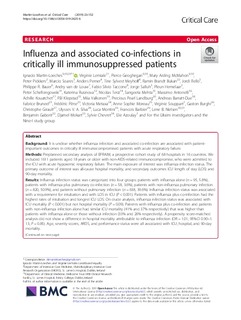| dc.contributor.author | Martin-Loeches, Ignacio | |
| dc.contributor.author | Lemiale, Virginie | |
| dc.contributor.author | Geoghegan, Pierce | |
| dc.contributor.author | McMahon, Mary Aisling | |
| dc.contributor.author | Pickkers, Peter | |
| dc.contributor.author | Soares, Marcio | |
| dc.contributor.author | Perner, Anders | |
| dc.contributor.author | Meyhoff, Tine Sylvest | |
| dc.contributor.author | Bukan, Ramin Brandt | |
| dc.contributor.author | Rello, Jordi | |
| dc.contributor.author | Bauer, Philippe R. | |
| dc.contributor.author | van de Louw, Andry | |
| dc.contributor.author | Taccone, Fabio Silvio | |
| dc.contributor.author | Salluh, Jorge | |
| dc.contributor.author | Hemelaar, Pleun | |
| dc.contributor.author | Schellongowski, Peter | |
| dc.contributor.author | Rusinova, Katerina | |
| dc.contributor.author | Terzi, Nicolas | |
| dc.contributor.author | Mehta, Sangeeta | |
| dc.contributor.author | Antonelli, Massimo | |
| dc.contributor.author | Kouatchet, Achille | |
| dc.contributor.author | Klepstad, Pål | |
| dc.contributor.author | Valkonen, Miia | |
| dc.contributor.author | Landburg, Precious Pearl | |
| dc.contributor.author | Barratt-Due, Andreas | |
| dc.contributor.author | Bruneel, Fabrice | |
| dc.contributor.author | Pène, Frédéric | |
| dc.contributor.author | Metaxa, Victoria | |
| dc.contributor.author | Moreau, Anne Sophie | |
| dc.contributor.author | Souppart, Virginie | |
| dc.contributor.author | Burghi, Gaston | |
| dc.contributor.author | Girault, Christophe | |
| dc.contributor.author | Silva, Ulysses V.A. | |
| dc.contributor.author | Montini, Luca | |
| dc.contributor.author | Barbier, Francois | |
| dc.contributor.author | Nielsen, Lene B. | |
| dc.contributor.author | Gaborit, Benjamin | |
| dc.contributor.author | Mokart, Djamel | |
| dc.contributor.author | Chevret, Sylvie | |
| dc.contributor.author | Azoulay, Elie | |
| dc.date.accessioned | 2019-11-13T13:15:56Z | |
| dc.date.available | 2019-11-13T13:15:56Z | |
| dc.date.created | 2019-09-14T18:22:24Z | |
| dc.date.issued | 2019 | |
| dc.identifier.citation | Critical Care. 2019, 23:152 1-10. | nb_NO |
| dc.identifier.issn | 1364-8535 | |
| dc.identifier.uri | http://hdl.handle.net/11250/2628288 | |
| dc.description.abstract | Background
It is unclear whether influenza infection and associated co-infection are associated with patient-important outcomes in critically ill immunocompromised patients with acute respiratory failure.
Methods
Preplanned secondary analysis of EFRAIM, a prospective cohort study of 68 hospitals in 16 countries. We included 1611 patients aged 18 years or older with non-AIDS-related immunocompromise, who were admitted to the ICU with acute hypoxemic respiratory failure. The main exposure of interest was influenza infection status. The primary outcome of interest was all-cause hospital mortality, and secondary outcomes ICU length of stay (LOS) and 90-day mortality.
Results
Influenza infection status was categorized into four groups: patients with influenza alone (n = 95, 5.8%), patients with influenza plus pulmonary co-infection (n = 58, 3.6%), patients with non-influenza pulmonary infection (n = 820, 50.9%), and patients without pulmonary infection (n = 638, 39.6%). Influenza infection status was associated with a requirement for intubation and with LOS in ICU (P < 0.001). Patients with influenza plus co-infection had the highest rates of intubation and longest ICU LOS. On crude analysis, influenza infection status was associated with ICU mortality (P < 0.001) but not hospital mortality (P = 0.09). Patients with influenza plus co-infection and patients with non-influenza infection alone had similar ICU mortality (41% and 37% respectively) that was higher than patients with influenza alone or those without infection (33% and 26% respectively). A propensity score-matched analysis did not show a difference in hospital mortality attributable to influenza infection (OR = 1.01, 95%CI 0.90–1.13, P = 0.85). Age, severity scores, ARDS, and performance status were all associated with ICU, hospital, and 90-day mortality.
Conclusions
Category of infectious etiology of respiratory failure (influenza, non-influenza, influenza plus co-infection, and non-infectious) was associated with ICU but not hospital mortality. In a propensity score-matched analysis, influenza infection was not associated with the primary outcome of hospital mortality. Overall, influenza infection alone may not be an independent risk factor for hospital mortality in immunosuppressed patients. | nb_NO |
| dc.language.iso | eng | nb_NO |
| dc.publisher | BMC (part of Springer Nature) | nb_NO |
| dc.rights | Navngivelse 4.0 Internasjonal | * |
| dc.rights.uri | http://creativecommons.org/licenses/by/4.0/deed.no | * |
| dc.title | Influenza and associated co-infections in critically ill immunosuppressed patients | nb_NO |
| dc.type | Journal article | nb_NO |
| dc.type | Peer reviewed | nb_NO |
| dc.description.version | publishedVersion | nb_NO |
| dc.source.pagenumber | 1-10 | nb_NO |
| dc.source.volume | 23:152 | nb_NO |
| dc.source.journal | Critical Care | nb_NO |
| dc.identifier.doi | 10.1186/s13054-019-2425-6 | |
| dc.identifier.cristin | 1724721 | |
| dc.description.localcode | © The Author(s). 2019 Open Access This article is distributed under the terms of the Creative Commons Attribution 4.0 International License (http://creativecommons.org/licenses/by/4.0/), which permits unrestricted use, distribution, and reproduction in any medium, provided you give appropriate credit to the original author(s) and the source, provide a link to the Creative Commons license, and indicate if changes were made. The Creative Commons Public Domain Dedication waiver (http://creativecommons.org/publicdomain/zero/1.0/) applies to the data made available in this article, unless otherwise stated. | nb_NO |
| cristin.unitcode | 194,65,25,0 | |
| cristin.unitname | Institutt for sirkulasjon og bildediagnostikk | |
| cristin.ispublished | true | |
| cristin.fulltext | original | |
| cristin.qualitycode | 2 | |

